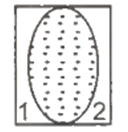 Multiple Choice Questions
Multiple Choice QuestionsThe focal lengths of the objective and of the eye-piece of a compound microscope are f0 and fe respectively. If L is the tube length and D, the least distance of distinct vision, then its angular magnification, when the image is formed at infinity is
An astronomical telescope has an angular magnification of magnitude 5 for distant objects. The separation between the objective and the eye-piece is 36 cm and the final image is formed at infinity. The focal length fo of the objective and fe of the eye-piece are respectively
45 cm and 9 cm
50 cm and 10 cm
7.2 cm and 5 cm
30 cm and 6 cm
If the reflected image formed is magnified and virtual, then the mirror system is
concave only
convex only
plane
concave or convex
A vessel of depth x is half filled with oil of refractive index µ1 and the other half is filled with water of refractive index µ2. The apparent depth of the vessel when viewed from above is
The refractive index and the permeability of a medium are respectively 1.5 and 5 x 10-7 Hm-1. The relative permittivity of the medium is nearly
25
15
6
10
A square wire of side 1 cm is placed perpendicular to the principal axis of a concave mirror of focal length 15 cm at a distance of 20 cm. The area enclosed by the image of the wire is
4 cm2
6 cm2
9 cm2
8 cm2
A thin prism P of refracting angle 3° and refractive index 1.5 is combined with another thin prism Q of refractive index 1.6 to produce dispersion without deviation. Then the angle of prism Q is
3°
4°
3.5°
2.5°
D.
2.5°
Given refracting angle of prism P
AP = 3°
and refractive index of prism P
µP = 1.5
and refractive index of prism Q
µQ = 1.6
(µP − 1) AP = (µQ − 1) AQ
(1.5 − 1) 3° = (1.6 − 1) AQ
or 0.5 × 3 = 0.6 × AQ
or AQ =
or AQ = 2.5°
Two piano-concave lenses (1 and 2) of glass of refractive index 1.5 have radii of curvature 25 cm and 20 cm. They are placed in contact with their curved surfaces towards each other and the space between them is filled with liquid of refractive index . Then the combination is

convex of focal length 70 cm
concave of focal length 70 cm
concave of focal length 66.6 cm
convex of focal length 66.6 cm
If the ratio of amounts of scattering of two light waves is 1 :4, the ratio of their wavelengths is
1 : 2
1 : 1
If the angle of minimum deviation is of 60° for an equilateral prism, then the refractive index of the material of the prism is
1.41
1.5
1.73
1.33
